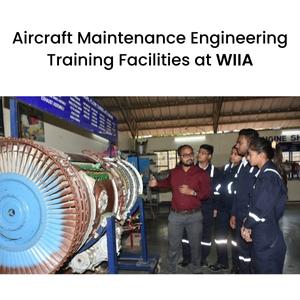
In today's dynamic world, where technology is rapidly evolving, the aviation industry is no exception. With the constant progress in the field of aircraft maintenance, the demand for skilled Aircraft Maintenance Engineers (AMEs) is skyrocketing. To meet this demand, it is crucial for aspiring AMEs to not only acquire theoretical knowledge but also gain practical experience. An AME course with a strong practical training component can significantly enhance a student's understanding of the subject matter and prepare them for real-world scenarios. In this article, we will discuss the importance of practical training in an AME course and its benefits.

Hands-on Experience: One of the primary advantages of practical training in an AME course is the hands-on experience students gain while working with real aircraft, tools, and equipment. This experience is invaluable in building their confidence, sharpening their skills, and enabling them to apply their theoretical knowledge in a real-world environment.
Enhanced Troubleshooting Skills: Practical training helps students develop effective troubleshooting skills, which are essential for a successful career as an AME. By working on actual aircraft systems and components, students learn to identify, diagnose, and resolve issues more efficiently, thereby improving their problem-solving capabilities.
Safety and Compliance Awareness: Working in the aviation industry demands strict adherence to safety protocols and regulations. Practical training in an AME course exposes students to the importance of safety measures and compliance with regulatory standards. This exposure helps them understand the impact of their actions on the safety and reliability of aircraft operations.
Familiarity with Industry Tools and Techniques: As technology in the aviation industry advances, so do the tools and techniques used for aircraft maintenance. Practical training enables students to familiarize themselves with the latest tools, equipment, and methods, ensuring that they are well-equipped to handle the demands of the job.
Improved Communication and Teamwork Skills: Aircraft maintenance is a collaborative effort that requires effective communication and teamwork among professionals. Practical training in an AME course allows students to work in teams, develop their interpersonal skills, and learn the importance of clear communication in the fast-paced aviation environment.
Better Job Prospects: Employers in the aviation industry prefer candidates with practical experience, as they are more likely to hit the ground running and contribute to the organization from day one. A strong practical training component in an AME course enhances a student's employability and makes them a more attractive candidate in the competitive job market.
Greater Adaptability and Flexibility: The aviation industry is subject to continuous change, and AMEs must be adaptable and flexible to keep pace with evolving technologies and regulations. Practical training fosters a proactive approach to learning and encourages students to stay updated with the latest industry developments.
Practical training in an Aircraft Maintenance Engineering (AME) course provides students with the unique opportunity to observe and learn from experienced professionals in the field. This exposure to industry experts allows aspiring AMEs to understand the nuances of their profession, gain valuable insights, and absorb the best practices in aircraft maintenance. By working alongside these professionals, students can acquire essential skills, such as effective communication, problem-solving, and time management, which are crucial for their success in the aviation industry.
Moreover, observing experienced AME professionals helps students develop a deep understanding of the safety protocols and quality standards that govern aircraft maintenance. These seasoned professionals can share their knowledge and experiences, shedding light on the practical aspects of aviation safety and the importance of adhering to regulations. This interaction ultimately helps students internalize the high level of responsibility and accountability required in their future careers as AMEs.


The World Institute of Innovative Aviation (WIIA) is a leading institution for AME training that focuses on providing a comprehensive learning experience for its students. The AME training facilities at WIIA are designed to ensure that students receive a balanced mix of theoretical knowledge and practical skills.
WIIA boasts state-of-the-art classrooms, well-equipped workshops, and advanced simulation labs that facilitate effective learning. The institution's faculty comprises experienced AME professionals who bring a wealth of industry knowledge to the classroom. These professionals provide students with an in-depth understanding of aircraft systems, materials, and maintenance procedures, ensuring that they are well-prepared to tackle the challenges of their future careers.
Additionally, WIIA's strong industry connections and collaborations with leading airlines and maintenance organizations provide students with exposure to real-world scenarios and the opportunity to gain practical experience in a professional environment.
WIIA's practical training facilities are designed to give students hands-on experience working with actual aircraft, components, and tools. These facilities include aircraft hangars, maintenance workshops, and specialized laboratories that simulate real-world conditions and environments.
The aircraft hangars at WIIA house various types of aircraft, allowing students to gain experience working on different airframes and systems. The maintenance workshops are equipped with the latest tools and equipment, ensuring that students are familiar with the technology they will encounter in their professional careers.
WIIA's specialized laboratories, such as the avionics lab, engine lab, and materials lab, enable students to delve deeper into specific aspects of aircraft maintenance. These labs are equipped with state-of-the-art equipment and technologies, allowing students to experiment, troubleshoot, and develop a solid understanding of the systems they will work with as AMEs.
In conclusion, practical training is an essential component of an Aircraft Maintenance Engineering course, as it provides students with the opportunity to observe and learn from experienced professionals and equips them with the skills and knowledge required to excel in their careers. Institutions like WIIA, with their state-of-the-art AME training and practical training facilities, ensure that graduates are well-prepared to meet the demands of the ever-evolving aviation industry.
